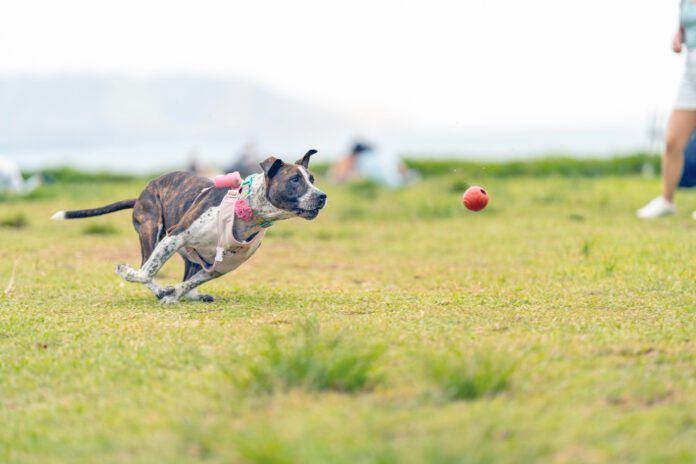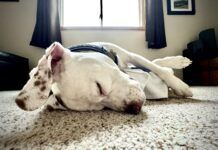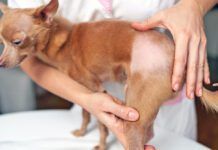If my dog sprains his leg, or is otherwise lame or sore, my immediate go-to is to run a cold hose over the area (or the whole leg) for 5 minutes two to three times a day. You need to time the 5 minutes because it will feel like an hour after just 30 seconds. I then limit the dog’s activity. I don’t usually give any medication on that first day.
Dog sprain recovery time is short for minor injuries, and often most of the pain is gone by the next day. Remember, though, even if he doesn’t seem sore, you should still rest the dog with crating and leash walking for a week. If your dog is still obviously sore the next day, he should be seen by your veterinarian.
Both sprains and strains are soft-tissue injuries, as opposed to a broken bone, which is an orthopedic injury. While soft tissue may seem simpler, these injuries can be extremely frustrating to heal and may take as long or longer than a simple fracture. Plan for a minimum of two to four weeks, with the possibility of months.
Dog Sprained Leg Symptoms
While the words “sprain” and “strain” get used interchangeably, technically, a sprain refers to an injured ligament and a strain to an injured muscle or tendon.
Both injuries can look similar when you examine your dog. The injured area may feel warm (compared to the normal leg) or be swollen in one area. Most likely, your dog will be less active and have trouble sitting or lying down or getting up. You might notice your dog avoiding stairs.
The stoic dog will be silent, although he may pull his leg away when you examine it and flex and extend joints. The sensitive dog will whimper, cry, and possibly even snap when you manipulate the hurt area. Most dogs will limp with an injured leg.
Sprain injuries tend to be acute. Your dog is bouncing around and then suddenly is holding up a leg. He could have sprained the ligaments in his carpus (wrist). If it is a rear leg, it may be the dreaded cruciate injury.
Strains are associated with joints, since ligaments act to hold the joint together. Strains are more likely due to repetitive stress but can be acute as well. For sport dogs, iliopsoas strains (think groin muscles) can happen acutely or with a buildup over time.
Treatment for a Dog’s Sprained Leg
Rest and cold therapy are realistic treatments for your dog. In some cases, support bandages can help, as can encouraging your dog to lie down quietly and rest.
I like to start with the cold hose versus an ice pack for two reasons:
- The cold water from a running hose stays cold unlike the ice pack, which warms up.
- As a veterinarian, I feel (anecdotally) that the action of running water on the leg is beneficial.
Veterinary Treatment for a Dog’s Sprained Leg
Your veterinarian will do a thorough physical examination, plus observe your dog moving. The affected leg will be carefully checked over, looking for redness, warmth, and swelling. The joints on that leg will be flexed and extended. Thermal imaging may pick up subtle injuries. At a sports medicine clinic, your dog may be gaited over force plates to compare his normal leg to his injured leg.
Treatment will vary with the injury. As discussed, mild injuries may respond to cold treatment and restricted exercise. Your veterinarian may prescribe an anti-inflammatory medication or a pain medication to make your dog more comfortable. Remember: Even if your dog seems fine after getting the medication, you still need to follow exercise restrictions. The drugs can cover up symptoms.
Severe injuries like complete tears of a cruciate ligament in the stifle may require surgery. Less severe sprains and strains may benefit from a bandage, splint, or brace. Always have these support items fitted by your veterinarian, even if you purchase them yourself. Some supplements such as Myos may be recommended as support.
Rehab for a Dog’s Sprained Leg
Perhaps most important for any sprain or strain is to get your dog into a rehabilitation program (like human physical therapy programs). If your dog is active in dog sports, schedule an appointment with a veterinarian certified in rehabilitation. The proper exercises can help to maintain strength and flexibility while your dog heals and reduce the likelihood of a recurrence. Some of these same exercises can be used to condition a dog and prevent injuries as well.
You might be flexing your dog’s joints manually or encouraging him to walk over cavaletti. Balancing on wobbly or uneven surfaces builds up proprioception (awareness of where his feet are) and his muscles.
Fit Paws has lots of fun equipment for every size dog. They also have blogs and articles on their site to help guide you in using the equipment but always follow your rehab veterinarian’s or veterinary technician’s guidance.
Along with fancy equipment, including underwater treadmills, some of the best results come from simple exercise such as sit/stand and controlled walking. You can also adapt things at home, such cardboard boxes for platforms.
Preventing a Dog’s Sprained Leg
How can you avoid sprains and strains? Start by keeping your dog at optimal weight. Any extra pounds mean extra stress on ligaments, tendons, and muscles.
Don’t count on your sport dog to stay sound as a weekend warrior. He needs exercise throughout the week as well to stay in shape. Each dog sport has exercises, including warmups, along with general fitness programs to ensure your dog’s condition. Chris Zink, DVM, has extensive articles, books, and videos at her site to help keep active dogs sound.
Finally, be realistic about activities for your dog. There are many dog sports. And the ideal sport may change with age or in the aftermath of an injury. Your dog may not be the ideal choice for a hard-driving agility dog but might be perfect for scent work. Find something you both enjoy.






